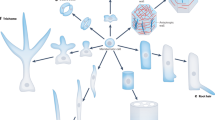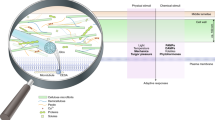Abstract
A CHARACTERISTIC difference between the processes of cell-wall formation in plants and animals has long been recognised. In the tissues of higher plants a new cell-wall is generally laid down on the nuclear spindle and then spreads peripherally until it cuts the cell into two. The cell-wall may thus be said to be endogenous in its origin. It is also generally believed that this plate on the spindle is first formed by the coalescence of a row of granules, afterwards splitting into two layers which secrete the primary wall between them. In animal cells, on the other hand, the characteristic method of division is by constrictions or furrows beginning at the periphery and proceeding inwards. The same is true of many Thallophytes.
This is a preview of subscription content, access via your institution
Access options
Subscribe to this journal
Receive 51 print issues and online access
$199.00 per year
only $3.90 per issue
Buy this article
- Purchase on Springer Link
- Instant access to full article PDF
Prices may be subject to local taxes which are calculated during checkout
Similar content being viewed by others
Author information
Authors and Affiliations
Rights and permissions
About this article
Cite this article
GATES, R. Cell-wall Formation. Nature 114, 788–789 (1924). https://doi.org/10.1038/114788c0
Issue Date:
DOI: https://doi.org/10.1038/114788c0
Comments
By submitting a comment you agree to abide by our Terms and Community Guidelines. If you find something abusive or that does not comply with our terms or guidelines please flag it as inappropriate.



